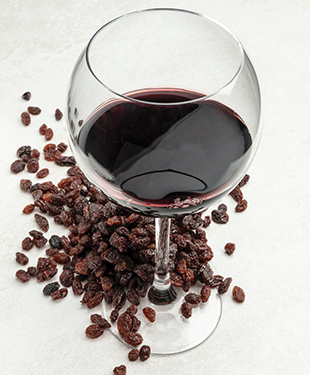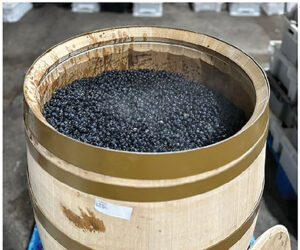
I grow wine grapes in my backyard vineyard, but I have a raisin connection, too. My grandfather, George Peak, grew 20 acres (8 ha) of Thompson Seedless raisin grapes in a vineyard near Selma, California. I spent many happy summer days on that property growing up — maybe the experience even helped me later decide to grow grapes of my own.
Why bring up raisins? It turns out they have a long history in winemaking. For home winemakers, raisins (dried grapes) can add body and flavor to a thin or unbalanced wine. They can contribute complexity and a bit of alcohol to an otherwise simple or bland wine. Raisins can improve balance and contribute a more wine-like character to some fruit wines. They can even be used to make an entire wine of their own.
Commercially, wines made from raisins have been produced in Europe since ancient times. In modern times, production has spread around the world. Most of the wines made entirely from raisins are quite sweet, with residual sugars in the range of 10% or more. In different languages, these wines are typically named some variation of raisin wine or straw wine. The latter name derives from traditional practices of drying grape clusters on woven straw mats in the sun (much the way my grandfather’s raisins were — and still are — sun dried on paper mats in the vineyard). The other most prominent way to dry them is hanging in an enclosed, well-ventilated space.
The island of Cyprus in the Mediterranean Sea has shown archeological evidence of sweet wine production as long ago as 4000 BCE. In the Middle Ages, a sweet raisin wine produced there was known as Commandaria. Commandaria is still produced in Cyprus in modern times, from freshly dried Xynisteri (a white grape) and Mavro (a red grape) raisins. In France, there are many individually named sweet raisin wines. As a group, they can be referred to as vin de paille, meaning “straw wine.” As in Cyprus, both red and white grape varieties are used in France, including Chardonnay, Poulsard (red), Marsanne, and Riesling.
In Italy, dried-grape wines share the collective term passito, derived from an Italian word for “withering.” Among the most famous of these is Amarone della Valpolicella. Unlike most of the other straw wines and raisin wines throughout Europe, Amarone is a bold, full-bodied dry red wine. Grape varieties employed include Rondinella, Molinara, Corvina, and Sagrantino (read more about this Italian variety in “Varietal Focus” on page 19). Clusters are harvested when ripe and traditionally were dried on bamboo racks. In modern Amarone production, the harvested clusters are sorted to remove any damaged fruit that might lead to rot and the clusters are then placed in plastic crates. The crates are arranged in drying rooms with forced air ventilation and desiccated for about 120 days. The shriveled grapes are then crushed and go through a cool fermentation period that may last one to two months. The wine is aged for two years in barrel prior to release. If fermentation is stopped and the raisin wine is left sweet, it is known as recioto. When pressed, the Amarone pomace (skins and seeds from the press) still has another use: Making ripasso wine. The pomace is added to partially fermented Valpolicella red wine made from the same grape varieties without drying, giving that young wine more tannins, body, color, and flavor.
Of course, New World winemakers are trying out various versions of dried-grape wines, too. California wineries are drying grapes from varieties like Marsanne, Rousanne, and Viognier prior to fermentation. In Virginia, Barboursville Vineyards produces a wine they call Paxxito by the traditional passito method. They air-dry Moscato Ottonel and Vidal grapes, then put them through a long fermentation and aging process. I have also heard of wineries in Texas and Australia making similar wines.
Grape skins that are shipped with wine kits serve some of the same objectives as the pomace used in ripasso wine. The skins, which are not dried, add tannins, color, and body to a fermenting wine. You can even buy packs of the skins separately from kits and make your own combination. Raisins are another source of more intense grape characteristics. They are much more readily available than packaged skins and are lower in cost. Since most supermarket raisins are sun-dried Thompson Seedless grapes, they do not contribute to red wine color. The brown color of typical raisins develops through enzymatic action on grape polyphenols during the drying process. So-called “golden raisins” are typically force dried in a mechanical process and are treated with sulfur dioxide to minimize the browning. Either type of raisin can add body, tannins, and complexity to a fermenting wine and will also contribute some fermentable sugars.
Since a significant contribution to tannins comes from seeds when making wine from grapes, seedless raisins will fall short in this area. The Wine RayZyn® Company, headquartered in Napa, California, offers an option that addresses that shortfall through their wine grape raisins. They offer three varieties of dried grapes: CabernayZyn® dried Cabernet Sauvignon, MerlayZyn® Merlot grapes, and ChardonayZyn® from Chardonnay grapes. All are harvested from California vineyards and then dried and packed by the company. All include seeds in the raisins and are promoted as a crunchy, healthy snack. For winemakers, these raisins can provide some of the character and contribution of skins and seeds.
When added prior to fermentation, any raisins will raise the sugar level and contribute to alcohol production. The U.S. Department of Agriculture (USDA) lists the sugar content of seedless raisins as 25 g in a typical 43 g (1.5 oz) box, or about 58% by weight. The proprietary RayZyns® list their sugars as a similar 22 g in a 45 g serving (1⁄3 cup) or about 49%. Some other specialty raisin products, such as large Muscat raisins, are often processed with edible oils (like sunflower oil) that may negatively affect your fermentation process if used.
Noting that raisins are about half sugar by weight, you can calculate an addition for a wine of your choice. Sugar fermentation by yeast yields about half alcohol and half carbon dioxide. To raise the alcohol level of wine by 1%, you need to add about 2% sugar. At near 20 °Brix, grape juice weighs about 10 lbs./gallon (1.2 kg/L). For a 2% increase, add sugar at a rate of 0.2 lb. (3.2 oz.) per gallon of juice (24 g/L). That means you will need twice that much in raw raisin weight or 0.4 lb. (6.4 oz.) of raisins per gallon (48 g/L). This translates to about 2 lbs. (0.9 kg) in a five-gallon (19-L) fermenter of wine.
The useful Winemaker’s Recipe Handbook by Raymond Massaccesi is filled with one-gallon (3.8-L) recipes for fruit, vegetable, and herb wines. His recipe for raisin wine calls for 2 lbs. (0.9 kg) of raisins along with 1.25 lbs. (0.57 kg) of sugar. A second recipe for raisin Sherry calls for 3 lbs. (1.4 kg) of raisins, plus 1 cup (237 mL) of light dried malt extract (available from homebrew supply stores) and 2 lbs. (0.9 kg) of sugar. Besides these raisin-based recipes, Massaccesi includes raisins as an ingredient in other recipes. His recipe for red tomato wine, for instance, includes one cup (237 mL) of raisins plus 3.5 lbs. (1.6 kg) of tomatoes and 1.5 lbs. (0.68 kg) of sugar, and his dandelion wine includes a pound (0.45 kg) of light raisins. His usual instruction for using the raisins is to chop them, then put in a nylon mesh bag in the fermenter.
One supplier of packaged grape skins offers similar instructions: Put the skins in a mesh bag in the fermenter and punch down daily just as you would for fresh red grapes. Other home winemakers who use raisins recommend first rehydrating the dried fruit in warm, chlorine-free water to cover. When cool enough, you can pour the plumped raisins and the soak water into the juice or diluted concentrate that you intend to ferment. If you will be using only raisins and sugar, with no added grape juice, the ratios in Massaccesi’s book provide a good starting point for your calculations. While some writers recommend washing raisins before use, that should not usually be necessary. Commercial raisins are washed (and then dried again) at the packaging plant before they are distributed. In the case of golden raisins, you may want to soak overnight before use to allow sulfur dioxide to dissipate.
Besides fermenting raisins as a contribution to your wine’s alcohol, you can also use them as a flavoring and sweetening component of finished wine. For that, you can add raisins (or RayZyns®) any time after primary fermentation. Since sugar will be extracted, the wine will need to be protected from refermentation by fortification (adding alcohol) or the use of sorbate and sulfites. If your objective is a strong, sweet dessert wine you may be able to use a combination of raisins, sugar, and fortification to make your own version of a vin de paille or passito.
I have one more family story about raisin wine. In the 1970s and ‘80s, my parents were volunteer workers in Bangladesh. While living in the upcountry city of Dinajpur, they became friends with the local Catholic bishop and his staff. Since my father had grown up on the Thompson Seedless vineyard mentioned earlier, and was in country as an agricultural adviser, he became interested in the work of the winemaking brother at the bishop’s house. At that time, sacramental wine was being produced entirely from imported raisins. While the raisin wine met the needs of the church, my father thought the subtropical climate of Dinajpur might allow cultivation of grapes to use instead. Long before I moved to Sonoma County and planted my own grapevines, I shipped five different dormant grapevines via Flying Tiger airfreight to my father in Bangladesh. He turned them over to the bishop’s winemaker and at least three of the vines were thriving by the time my parents came back to the U.S.
Whether you just want to boost the character of a tomato wine this summer or want to go all the way to making an Amarone or recioto wine that can age for years, consider adding some raisins to your winemaking pantry.






